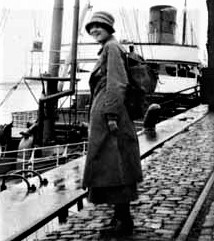In 2016 when researching in South Shields Library about Historian and Photographer Amy Flagg (1893-1965), as well as her photographs of damage to the town by German air attacks during the Second World War, there was a number of personal scrapbooks full of the towns history and genealogy of families in the borough.
Also included was ‘Air Raids on South Shields’, these typed notes and diary entries were a record of official statistics of enemy attacks since the first bomb dropped in 1940.
The next few posts feature selected pages from Amy’s war diaries. Detail from Tyneside newspapers and maps have been added to some entries.

In this post Miss Flagg describes in great detail a large scale enemy attack by over 70 German planes.
Water, gas and telephone lines damaged, shipyards under siege, trains flung around like toys, houses obliterated, Ingham Infirmary on full alert. An attack so severe that one of the largest bombs in the country, a ‘Satan’, was dropped on the town.
Fire brigades from across the North East were called in to help – it was a night when South Shields was caught in a ‘blitz by fire’.
Thursday 10th April 1941:
Shortly before the siren sounded, enemy aircraft were heard, ground defences became very active and two high explosive bombs were dropped. Then came a shower of incendiaries, an estimated 6,000 falling in the Tyne Dock area, Mile End Road, River Drive and Wapping Street district.
It soon became clear that a large scale attack was developing and directed on the shipbuilding, ship repairing and timber yards on the riverside.
After this, a series of flares were dropped, illuminating the whole region. Major fires were started on the west side of Tyne Dock, Redhead’s Yards, Middle Docks, Tyne Dock Engineering Company, Wardle’s Timber Yard and Brigham and Cowan’s Store Shed.
The Queen’s Theatre, the Railway Station tower and houses in Fawcett Street and Robertson Street were ablaze. Houses in Westoe Road, Tyne Dock and east Jarrow were also involved.

The resources of the Fire Services were fully extended and a call for ‘Mutual Aid’ had to be made – this was a reciprocal system that enabled a service to get help from other districts.
Fire Brigades from Durham, Gateshead, Middlesbrough, Newcastle and Sunderland arrived, each town sending their complement of Rescue and First Aid Parties.
During the progress of this blitz by fire, a large number of high explosive bombs were dropped, causing great havoc. The largest number of casualties were found in the Mile End Road area, including Empress St, Palatine St, Fort St, and William Terrace.
Two large calibre bombs fell close together in this thickly populated part of town, completely shattering a whole block of houses. Bombs also fell on the railway line near Studley Bridge and Ellesmere Street, where passenger coaches were flung about like toys.
Several bombs fell in Redhead’s Yards, doing much structural damage. Bombs also fell in Cayton and Armstrong’s Timber Yard, the TIC Docks, Middle Docks and a Fire Station in Anderson Street, and on the Battery Field at Westoe.
In King George Road, two houses were obliterated, and a bomb also fell at the Deans. Prince Edward Road West was blocked by a large crater on the embankment below Dean Terrace. A water main burst, filling the crater and burying a motor car in mud.

One of the largest bombs dropped in this country to date, was found unexploded in Newton and Nicholson’s premises, Templetown. It was a 1,800kg bomb, recognised as a ‘Satan’.
The estimated number of bombs dropped was 38, but this does not include many which fell in the river, the harbour and the sea near the pier.
50 people were rendered homeless or evacuated. Two Rest and Feeding Centres were opened and maintained until all were housed elsewhere.
On the following morning a request for the help of fifty men was made under the Police Mutual Aid Scheme. Two Mobile Canteens also came to supplement local arrangements for the feeding of personnel.
Casualties – 25 killed, 11 seriously injured, 65 slightly injured. Toll in human life was also taken at the Mile End Road area where a family of four was wiped out, but their pet spaniel was rescued alive after 80 hours.
Four soldiers were injured at Marsden Battery through a shell burst from their own gun. Three suffered from head injuries and one from abdominal injury.
Alikivi April 2021
Link to Amy Flagg’s war photographs on the excellent South Tyneside History website.
https://southtynesidehistory.co.uk/
Link to Amy Flagg documentary ‘Westoe Rose’.